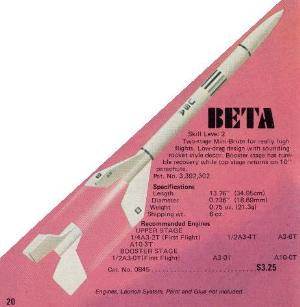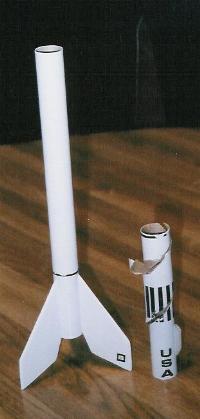| Construction Rating: | starstarstarstarstar |
| Flight Rating: | starstarstarstarstar |
| Overall Rating: | starstarstarstarstar |
| Diameter: | 0.74 inches |
| Manufacturer: | Estes  |
| Style: | Multi-Stage |
Brief:
The Beta was a small two stage rocket produced by Estes between 1970 and 1984. The original version, produced in 1970 and 1971, it was powered by S-series motors. When production ceased on the S motors, the Beta was one of a few kits whose internals were modified to accept the new mini or T motors. (The Midget and the Birdie may have been the others.) The Beta was the rocket that got me started in rocketry back in the summer of 1977, and with the 25th anniversary of that first flight coming up this July, I felt it would be a fitting tribute to build a clone.
 Construction:
Construction:
- 1 - EB-5B engine block
- 2 - BT-5T engine mount tubes
- 4 - AR-520 adapter rings
- 1 - BT-20AE booster body tube
- 1 - JT-20C stage coupler
- 1 - BT-20B upper stage body tubes
- 1/32" basswood fin stock
- 1 - LL-2A 18" sewing elastic
- 1 - screw eye
- 1 - BNC-20N nose cone from BMS
- 12" parachute
Following the original instructions that I downloaded from JimZ, the Beta was and is a simple, almost foolproof build. I used an Estes fin alignment guide to line up the fins for the first and second stages. Despite the care I took in making sure the stages lined up, it turns out that they do so in only one configuration. An oddity, but far from a fatal flaw. I used basswood in place of balsa for the fins in the hope that the extra weight would be offset by the greater strength. The only thing resembling a "gotcha" was the fin pattern. The tracing needs some work to be able to produce first and second stage fins that actually fit together as they were meant to. Just make sure that all of your lines square up and you'll be okay.
Finishing:
Thinned Elmer's Fill & Finish was used in both body tube and fin finishing, and since I had substituted basswood in place of the balsa fins, I was able to greatly reduce the time I spent sanding the fins to a nice, smooth, decal friendly finish. After a coat of primer and the requisite sanding, I sprayed the entire model with Krylon gloss white. Decals were from JimZ and the rocket turned out looking almost dead on the picture in the 1977 catalog. The only difference was that I used the A, B and C decals on both stages of my original. (It still isn't an exact replica of my 1977 model. I actually bothered with sealing and sanding this time.)
Construction Rating: 5 out of 5
 Flight:
Flight:
While I'm thrilled to have a copy of my first rocket in the fleet, the Beta in it's two-stage form is an endangered species as Estes has seen fit to discontinue the A10-0T engine. While this promises to be a problem down the road, it currently is of little consequence as I took care to buy out every pack locally. (One pack is even on the pink card, just like it was when I was 14.)
For it's first flight I chose a 1/2A3-4T to go along with the A10-0T, hoping to keep it in sight on it's first flight. This turned out to be a fatal error on my part. While the 1/2A3-4T is listed as an upper stage engine, it has a smaller nozzle opening than the A10-3T that I should have used. Since I had never flown my original as a two stager, (due mainly to 1977-level monetary concerns,) I was particularly excited with the possibility of the two stage flight. It launched perfectly straight and as I watched it streak off the pad, I was anxiously anticipating the lower stage separation. It never came. The rocket tipped over at apogee and began screaming back toward the soft earth of the soccer field. For a moment I held out slim hope that the soft ground would cushion the impact somewhat, but the sticky smacking sound that it made as it buried it's forward section deep in the mud changed my mind quickly. The only good thing about the timing of the lawn dart was that I hadn't yet ordered the balsa cone from BMS, so all it took to retrieve the undamaged cone was long fingers. I wasn't so lucky with the body. It was immediately evident that the top four inches of the body tube would have to be replaced before it's next flight. This wasn't a hugely complicated project, however I realized that the decals would have to be re-ordered if I was going to have the same look as my original. Or so I thought.
 I had recently bought a starter pack of inkjet decal paper from Bel Decal. Since I didn't feel like waiting through the order and delivery process again, I decided to attempt to make a set of my own on my home computer. For some unknown reason, they didn't turn out very well. They worked, and from a distance you would be hard pressed to notice a problem, but up close it was obvious that the black ink had cracked and taken on an alligator skin-like finish. After a spray of clear the decals worked fine, but the whole thing looked less than perfect. (Considering the repair seam in the body tube that I was only partially able to hide, this isn't a huge deal.) I've since found that the decal making process works well on some printers, not so well on others. Live and learn.
I had recently bought a starter pack of inkjet decal paper from Bel Decal. Since I didn't feel like waiting through the order and delivery process again, I decided to attempt to make a set of my own on my home computer. For some unknown reason, they didn't turn out very well. They worked, and from a distance you would be hard pressed to notice a problem, but up close it was obvious that the black ink had cracked and taken on an alligator skin-like finish. After a spray of clear the decals worked fine, but the whole thing looked less than perfect. (Considering the repair seam in the body tube that I was only partially able to hide, this isn't a huge deal.) I've since found that the decal making process works well on some printers, not so well on others. Live and learn.
For the second flight, (a month later,) I took the advice of the QUARK senior advisor and loaded the refurbished Beta with the preferred A10-0T/A10-3T combination. This time the rocket left the pad at an angle and was still traveling on this path when the second stage lit. With the exception of the angle of the flight path, this flight was perfect. The booster floated back to within 50 feet of the launch pad, while the sustainer recovered several hundred yards down range on it's 12" parachute. Not exactly a textbook flight, but very entertaining anyway.
Flight Rating: 5 out of 5
Summary:
While the Beta is a seldom seen rocket, it's appearance doesn't inspire much along the way of comments or recognition at launches. It's a fairly vanilla 3FNC rocket with only the fact that it is a two stager to distinguish it, but most of us will admit to a soft spot for our first rocket. With the loss of the A10-0T in the engine lineup, you're on borrowed time as far as flying it as a two stager. (Unless you happen to have a stash like I do.)
Overall Rating: 5 out of 5
 |
 |
Flights
 |
 |
Sponsored Ads
 |
 |












Rich DeAngelis (December 9, 2011)
For anybody who may not be aware: The A10-0T engine is back in production! My Estes Beta flies again!